Robert Pruvenok Accepted to NSA REU
Yes, this REU requires an security clearence. It is the National Security Agency after all. This REU admits many times the number of slots availible, presumably because the attrition rate due to the 28 pages, arriving at Thanksgiving time, and the polygraph test, will dissuade many people from following through.
I certainly hope that Robert gets through the whole process. The REU promises to be quite interesting. As for the rest of you, especially juniors, deadlines for many REUs fall in January and February of next year. I'll be telling you about those early next term.
How to Apply for NSF Grad Fellowships
GT, Mathematics, and Double Majors
As these 40 majors can tell you, the commitment to a second degree is substantial: It requires that they meet all degree requirements plus an additional 36 hours! That is, a second degree is two 18 hour semesters of additional course work. These majors who pursue this path are gaining not only certification of a high degree of proficiency in their fields, but taking an addtional year of courses, typically at the senior level.
But, as I recently found out, at UGA, it is quite easy to aquire a second degree. There is no additional hour requirement. You simply fullfill the degree requirements, taking some care to fit all the required courses into your four years of study. Not only that, but the trend to multiple degrees is exploding. Some students are now aquiring four degrees--at universities that do not have GT's hour requirement obviously.
For example, at UC Berkeley, the Chair of Mathematics has announced with pride that he tripled the number of math majors, from about 150 to about 450, mostly by promoting the second major. It is a striking increase. Yet, I'll bet that there is no hour requirement on the second major, and that Berkeley Math was simply riding a national trend.
Our double majors are crossing a much higher bar than those of most other universities. So, when these majors are leaving GT, they should be sure to point out this higher standard so that they can receive credit for their accomplishment. In the same way, Profs at GT, writing letters of recomendation, should point out this higher standard.
Nathan Bell's Senior Project on Computer Graphics
The senior project can be what ever is agreed to between the student and faculty sponsor. A student can have a project in mind, and seek a sponsor. Or the student can select a sponsor, who then selects the project. In either case, it an opportunity to explore a topic outside of the structure of a classroom, or textbook.
This has all worked very well for Nathan Bell, currently working on a project in Computer Graphics, with Professor Mucha as the sponsor. Nathan begain with the the idea of modeling balls falling down a slo pe, and Professor Mucha has modified the project to handling sand falling in an hourglass.
The project has progressed very well, and promises to develop into a quite impressive bit of applied mathematics and coding. Nathan has generously let me include a statement of his. Be sure to follow the links down at the bottom to get to his pics.
When asked about the single most difficult shot in "Shrek", producer
Jeffrey Katzenberg replied "It's the pouring of milk into a glass."
It is both tedious and time-consuming to animate natural phenomena
manually. Moreover, given people's familiarity with natural
phenomena, it is unlikely that a manual animation would be convincing,
in a photorealistic sense. For these reasons, physics-based models
are highly desirable in computer graphics simulations of natural
phenomena. My present research, in collaboration with Peter J. Mucha
in Mathematics, aims to produce a computationally efficient,
physics-based model of granular media for computer graphics. The
computational efficiency of our model is due to the use of different
methods for different physical scales; in computational physics
terminology, our approach is multiscale. Our objective is a realistic
animation of a sand hourglass.
At the smallest physical scale we use a microscopic model of particle
interactions. Our approach uses molecular dynamics techniques, a
well-established practice in Computational Physics simulations of
granular media. Three different forces govern particle interactions:
- Restoration: Overlapping particles repel one another
- Dissipation: Particle collisions are inelastic
- Shear Friction: Particles resist movement against surfaces
These forces are sufficient to capture common characteristics of
granular media such as an angle of repose and load-bearing along
walls. The sand hourglass illustrates both of these properties. The
sand though an ho urglass flows at a constant rate due to the
frictional load-bearing of the walls. The sand at the base forms a
heap with a slope equal to the angle of repose. To provide a visually
convincing animation, it is important for a model of granular media to
exhibit these characteristics.
Presently, we have a microscopic model capable of modeling the
hourglass or a landslide, among other systems. The model is
implemented in the C++ language and rendered using the OpenGL graphics
library. Our implementation uses techniques and practices from
Computational Physics, Applied Mathematics, and Computer Science.
Among these techniques are:
- Molecular Dynamics:
MD provides the basis for our microscopic model.
- Numerical Methods for solving ODE:
We use an adaptive Runge-Kutta algorithm to advance the system
through time.
- Efficient Data Structures and Algorithms:
Our model is implemented with competitively optimal data
structures and algorithms (e.g. Red-Black trees)
Particles are modeled as spheres which interact with boundaries.
Boundaries can be finite planes as well as curves rotated about an
axis. These objects are sufficient to accurately model the hourglass.
Microscopic models are appropriate for systems of thousands or tens of
thousands of particles. However, such models are too computationally
expensive to apply to systems of hundreds of thousands or millions of
particles. Our focus now is the development of a multiscale algorithm
capable of communicating the essential physical interactions between
the microscopic simulation and a macroscopic model of the "bulk" of
the system. At any time instant, the vast majority of sand particles
in the hourglass are stagnant. From an animation standpoint, the
detailed microscopic interactions in the bulk are unimportant to the
realism of the simulation. This observation will allow us to
significantly reduce the computat ional cost of the simulation by using
the microscopic model for particles near the surface of the volume and
using an appropriate macroscopic model for the bulk. As in any such
multiscale approach, the key questions to be answered are in the
interface between the microscopic and macroscopic models. Answering
these questions in a satisfactory manner will enable us to animate
hourglass systems with a far greater number of particles, since the
vast majority of the particles will be suitably approximated by the
macroscopic model, the remaining limiting factor being the microscopic
molecular dynamics simulation of the far smaller number of particles
in active motion near the surfaces.
Georgia Tech requires Discrete Math majors to complete a two-semester
senior project. Initially, the prospect of two semesters of research
was daunting, as I have had little previous research experience. In
late August I approached Peter Mucha with a research idea. From my
initial idea, simulating marbles flowing through a funnel; grew our
present objective, simulating granular media. This topic fits
particularly well with Prof. Mucha's other research interests such as
efficient numerical methods for simulating sedimenting suspensions.
Since August, I have been exposed to a variety of subjects with which
I had no prior experience. Topics such as numerical methods for
solving ODE and molecular dynamics were previously unknown to me.
Using these techniques in my research has led me to pursue relevant
courses. In short, this experience has piqued my interest in
research.
Source code and Images of the project can be found at:
http://www.schwanz.org/~nathan/
The most recent images are here:
http://www.schwanz.org/~nathan/screenshots/misc/stress/ (colored by stress)
and here:
http://www.schwanz.org/~nathan/screenshots/v0.1.8/ (colored by velocity)
Ten Students apply for NSF Grad Student Fellowships
Nine of the ten students are current students: Brandon Meredith, Yakov Kerzhner, David Skoog, Blair Dowling, Nathan Bell, Clark Alexander, Ganesh Sundramoorthi, Alan Michaels, and Roberto Lopez. Several of these students have contributed their essays, as example jumping off points for next year's juniors.
The eleventh student is Andy Wand, who parlayed a GT REU into admission and support for Math Graduate School at Berkeley. First year grad students can apply for the NSF support!
Topics on the research proposals part of the applications ranged from engineering and statistics, to pure math, to computer science (two differnt approaches to compiling, and computer graphics). Some of these same students can make applications to the Computational Science Fellowships, with deadline in January.
There has been even more activity, with Clark Alexander, Blair Dowling, David Eger, and Alan Michaels preparing additional applications for other fellowships. David Eger has applied for a Fulbright to do graduate work in Budapest. The other three have prepared applications for "prestige" fellowships, e.g. Rhoades Fellow. Blair Dowling and Alan Michaels have interviews for the Marshal Fellowships, for graduate work in Britian, on Nov. 21.
Juniors: Want to get a heads up on Grad School applications? Follow Mason Porter's advice and take the GRE subject and general tests in the Spring semester. You have already learned the math that appears on the subject test--some of it is Calculu s, for example--and that will give you a little more time during the fall term, plus the opportunity to retake the exam if you are not happy with the score.
Hynd, Lopez and Elms presented paper at Salt Lake City Regional AMS Meeting
The paper concerns a question that goes back to the origins of soap film type experiments. Take a viscous liquid, like an oil, and spin it in a weightless environment. Carrying out this experiment yields a very broad range of possible shapes that the oil drop can take. The paper has two components, first characterize the profiles that the drop can take as solutions to a certain differential equation, and second carry out this experiment.
By all accounts the presentation was very good, and well received. Roberto Lopez wrote to me the following message.
From roberto_eduardo@yahoo.com Tue Oct 29 14:49:31 2002
Mr. Lacey:
I am proud to say that Ryan did an outstanding presentation. Everybody who attended
the presentation praised Mr. McCuan and all of us, in particular Ryan.
Well, what can I say I truly enjoyed my experience in SLC but mostly
because I met and worked with Ryan, Jeffrey and Mr. McCuan. I will always
remember this wonderful experience in my heart. Thank you so much for
giving me this opportunity, I do really feel priviledged for that.
Kindest Regards;
Roberto.
< /pre> After the presentation, the three of them spent some time with other professors who attended the special session, especially Professor Frank Morgan, of Williams College. Professor Morgan is very well known for his research in minimal surfaces, and as being an outstanding mathematics teacher.
The research by Hynd, Lopez and Elms was begun in the REU program from the Summer of 2002 and carried out in the ACE Lab. Their research and travel were supported by the NSF VIGRE grant to the School of Math.
Practice Democracy by Contributing to the Math Majors CoWeb
What is a CoWeb? It is a site editable by anyone and everyone. So it is democracy in action, and generally more useful the more people who use it. So check it out.
Undergrad Lunch in Skiles 236, Math Lounge, Oct 29, 11:30-1pm
Mercer Human Resource Consulting, a national actuarial firm, Holding Open House, Inviting Math Majors
Actuarial Science is a significant part of the Insurance Industry, a heavily quantitative field, for which mathematics serves as an excellent training for student to move into this field.
Here is their message to me, forwarded to all math majors:
Mercer Human Resource Consulting, a national actuarial firm, we will be
holding an open house at our Atlanta office on October 21, 2002. Mercer is
looking for both juniors and seniors, pursuing a B.S. in Mathematics, for
either an internship or a full time entry-level position.
For those of you who are not familiar with the actuarial profession, please
visit www.beanactuary.com or our company's website, www.mercerHR.com.
For those of you that are interested, please contact Michael Lacey
for an invitation. There are only 20 spots available for the open house and
the spots will be filled on a first come first serve basis. If you have any
questions, please do not hesitate to call.
Thanks,
Brian Maddox
Mercer Human Resource Consulting
Atlanta, GA, US
Blair Dowling to meet College of Science Board
The Advisory Bo ard consists of graduates of the College of Science who have gone on to significant positions of leadership in sciences and industry. One of the members of the board is an Applied Math major, now CEO of Greyhound Buses.
Invited to speak to the Board at this meeting are four women. An early alumni Jean RAY BS '65, the first femail chemistry major at Georgia Tech. A current faculty member of the College of Science. A recent student is Katie Saliba, an NSF graduate fellow at Cal Tech. And the current student is Blair Dowling.
These four women will have a 10-15 minute discussion with the Board about their experiences at Georgia Tech and how that has shaped their career development and personal experiences.
Blair is a double major in Math and Computer Science, as well as a minor in Economics. She has taken on a number of leadership roles on campus. And so is a great choice to speak to the Board.
New Class Info is Updated.
New Web Page Geared for Mathematics Majors
The American Mathematical Society an important nationwide organization to promote Mathematical Research nationwide. This web site has links for
Oct 30: Fellowship Bang it out Evening for Seniors
That is about 8 days before the Deadline of Nov 7.
A good bit of the Fellowship application material can be submittedover the web. So expect to be using the Undergrad Lab that evening. We'llhave another room to hold bull/Pizza session on the Plans of Research andPrevious Research Experience.
Why hold it? 'Cause off the top of my head I can think of about10 of you that should apply for this Fellowship. many applicants will be stuckon the "Previous Research Experience" and "Research Program" Statements. Let's get on past these things! Here is more more detailed info about theFellowships:
I'll see you there. BTW, I won't be around during the next three weeks or so. I'll be in Europe. Got a position in at a University in Paris. But that doesn't mean that I won't be posting some blogs :-)
NSF Grad Fellowship
http://www.ehr.nsf.gov/dge/programs/grf/grfp.asp
October 24: Bang it out Evening @ Skiles. 5-7pm.
NOVEMBER 7 ----Big Deadline
The Form below can be filled out by paper or by through
www.fastlane.nsf.gov Look for the Grad Research Fellowhship Link
on the left hand side.
Information Form (Standard Info)
Application Form
Plan of Research
Previous Research Experience
Undergrad GPA Form
Official Transcript
DECEMBER 5
Reference Reports (4 rec ommended)
GRE Scores, general and subject have to be reported.
Aim to take the Nov 15 Subject Test.
NSF will pay the fee for the Dec GRE Subject test. I'll
bet that you can only have the score reported to the NSF !
though.
Ryan Hynd will be a FACES Scholar
The FACES program has undergrad and grad components. The undergradcomponent description is: Undergraduates, who are upperclassmen in the Collegesof Computing, Science and Engineering are solicited to apply to the FACESUndergraduate Scholars Research Program. As a FACES scholar, the studentsperform research under the supervision of an academic faculty member. Anominal effort of 10 hours per week is expected for which the student willreceive a stipend of $1000/semester. As part of the research experience,each participant is expected to complete a report summarizing the resultsof their research and prepare a final presentation in the spring semester. The program offers talen ted undergraduate students the opportunity to becomeinvolved in research in the hope that t! hey will be motivated to pursue graduateeducation. While the program offers the students the obvious advantagesof early exposure to research, it offers participating faculty the opportunityto mentor promising students and gain assistance with research.
Ryan was also a participant in last summer's REU program, in whichhe conducted research in the ACE Lab. There is moreabout Ryan below.
Discrete Math Majors: Don't neglect DifferentialEquations!
For most majors, that seems OK. Recently, however, I have talkedto two D-Math majors, who are graduating soon, and reasons for feelingsorry that they haven't taken Differential equations. (What a drag to besenior taking a 2000 level math course. Unless it is Honors Diff Eq!) Oneis looking to go into genomics and biology. The other is doing his seniorproject under Professor Mucha in computer graphics--which uses all the math it can to make the graphics computable and interesting.
Each year, the Technique publishes "100 Things To Do Before LeavingGT." And every year one item is "Understand what differential equations arefor." A wide variety of physical phenomena can be understood in terms oftheir local changes, but exhibit very rich behavior at larger scales. Justthink of the weather. Di! fferential equations turn out to be excellent descriptorsof these phenomena. That is reason enough to take the course.
Ryan Hynd Receives Presidental Undergraduate Research Award
Ryan also participated in the REU program this past summer, working in the ACE Lab. And he will be traveling to Salt Lake City in October to present a paper that resulted from the REU.
The PresidentalUndergraduate Research Award are competitively funding individual requests by a faculty/student team for funds to be used to support undergraduatestudent involvement in faculty research. The main thrusts of theseawards will be for student salaries, material & supplies needed for student research, and travel expenses for undergraduates to attend professionalmeetings to give presentations.
See the web site above for more information, and a list of other Undergraduate Research opportunities. The next b! ig opportunity in the School of Mathematics will be the Summer VIGRE/GT Research Experience for Undergraduates program. Past information on that program is at this site and will be updated shortly.
P utnam Exam Practice Sessions: Monday 4:30-6 in Skiles 140
Each university can select a team to represent it. Prizes are offered for the top teams, and best individua l test takers. Over the 60 years of the exam, many of the top participants have gone on to bright careers in mathematics and the sciences in general. Several have gone on to win the Nobel prize in Physics.
Each year, Professor Wang runs weekly problem sessions to practice for the Putnam. Last year, the GT team placed 23rd out of 453 teams. Two takers, Anup Rao and Billy Fransico, scored 41 points, putting them at 143rd among all exam takers. Details are on last semester's blog. A history of most of the prize winners is availible as the Mathematical Association of America website.
!The MAA also offers a book of problem solutions. (The authors of this book are no slakers!)
The current competition committee consists of :
Three of these, Granville, Pomerance, and Klosinski, are top numbertheorists. James Prop made it into last semesters Blog with a fiendish self-referential exam. Some of the majors claimed that I was trying to sabatoge their degrees by pointing this out to them during finals week.
Assoc. Dir. Gerald L. Alexanderson
2005
Andrew Granville
2003*
Director Leonard F. Klosinski
2005
Assoc. Dir. Loren C. Larson
2005
Carl Pomerance
2003*
James Propp
2004
Brian Walden
2005
Brandon Meredith Continues His Stay in France
The "Bayesian networks" that I'm working on now are very interesting and have a very promising future. I was thinking about applying for theNSF fellowship with a question in BNs. It's a subject that came out aboutonly 10 years ago, it's developing a large following very quickly, and itsits astride subjects as far reaching as philosophy, the social sciences, computer science, and of course, mathematics (which should meet the NSF's 'broader impacts criterion').
I still plan on coming back to GaTech in the spring semester and graduating at the end of it.
ACE Lab Group to Report on Results
The ACE Lab only recently constructed, is a Lab in the School of Math, designed to enhance the education of undergraduates and graduates by combining elements of experiment, theory and modelling. Follow the link above for a nice view of some pictures of recent experiments taken by the lab's high speed camera. Currently, the Honors Differential Equations course is taught with a ACE lab component,and a graduate course, Industrial Mathematics.
All three students worked long hours in the ACE Lab this past summer. A key experiment involved suspending an oil drop at the end of a rod in a water solution, and then rotating the rod. The oil drop initially moves in a centrally symmetric fashion, but some surprising shapes evolve! Just check out the movie that opens up the ACE Lab web page above. I include the abstract of the ACE Lab report:
Title: Delaunay's rolling curves and rotating drops.
Authors: J. Elm, R. Hynd, R. Lopez, J. McCuan
Abstract: In 1841, Delaunay described the meridian curves of all constant mean
curvature surfaces of revolution. Each is the path traced out by the focal
point of a conic section as the conic section rolls along the axis of symmetry.
In 1863, Plateau examined the shape of a neutrally buoyant liquid drop
driven
to rotate about its axis of symmetry. The mean curvature of these surfaces is a
quadratic function of radial distance. The shape and stability of Plateau's
rotating drops have been examined by many authors. We discuss an extension of
Delaunay's rolling curve interpretation to this important class of surfaces of
prescribed mean curvature.
Meet the Math Majors Very Well Attended
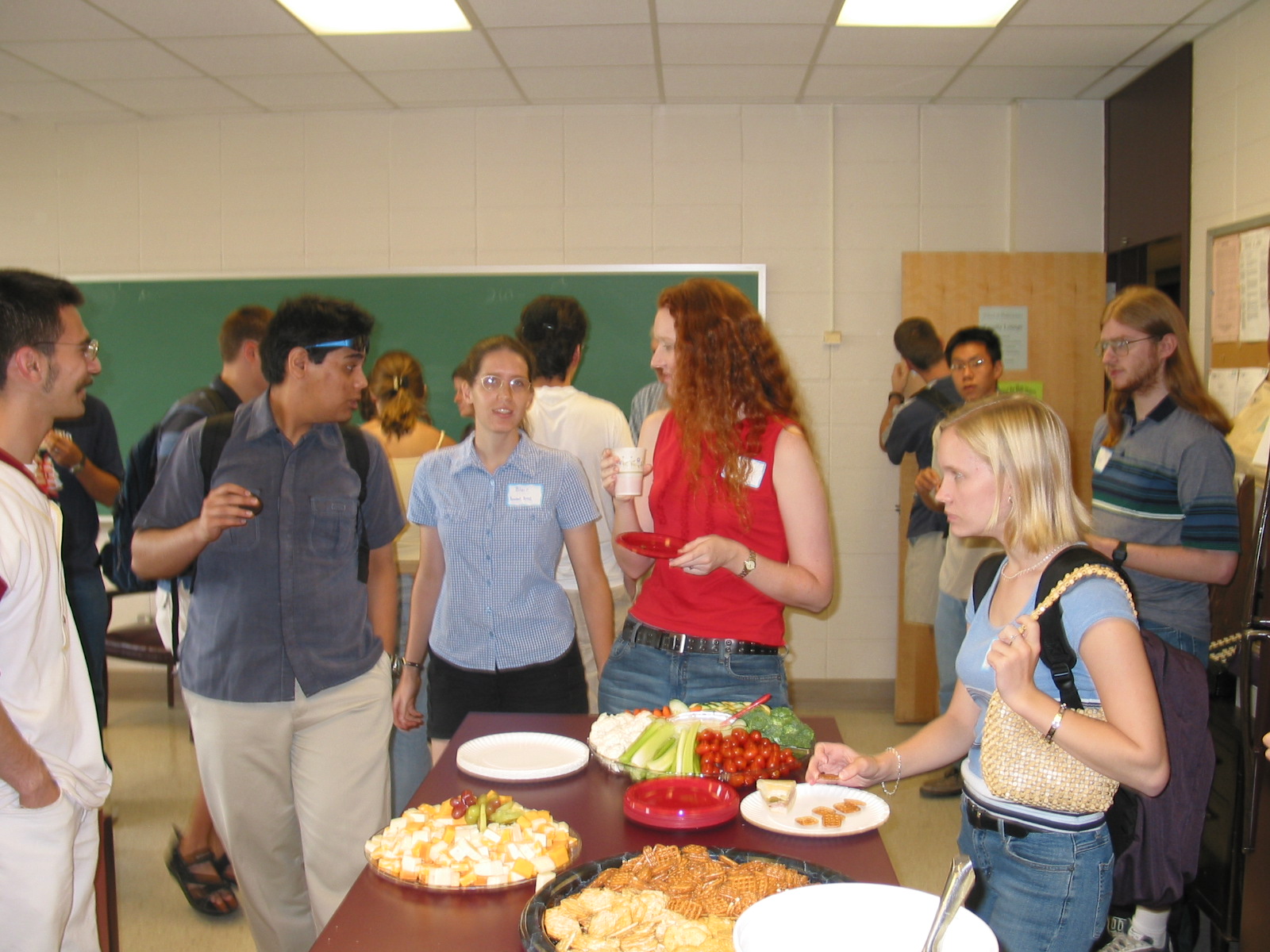 |
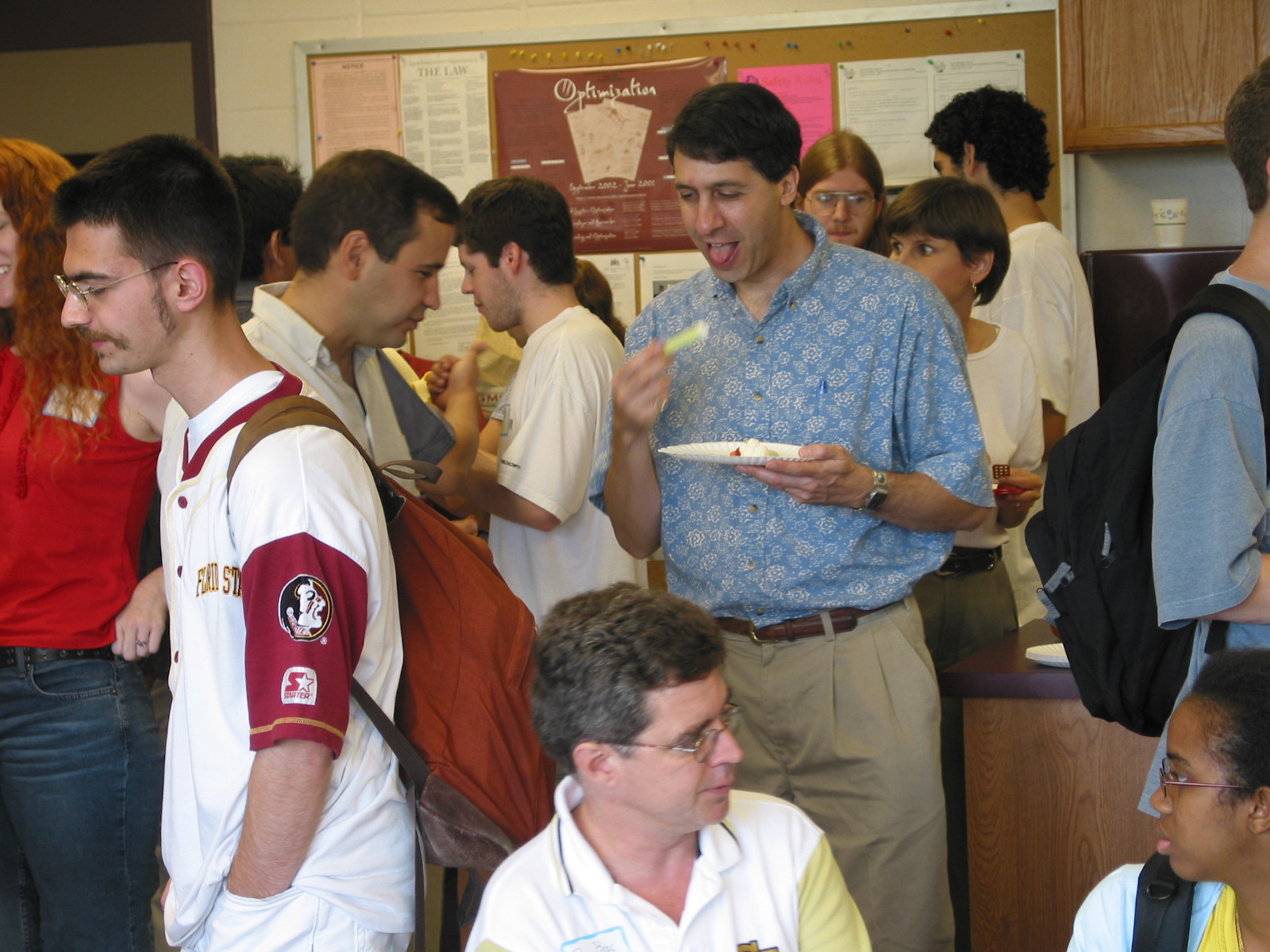 |
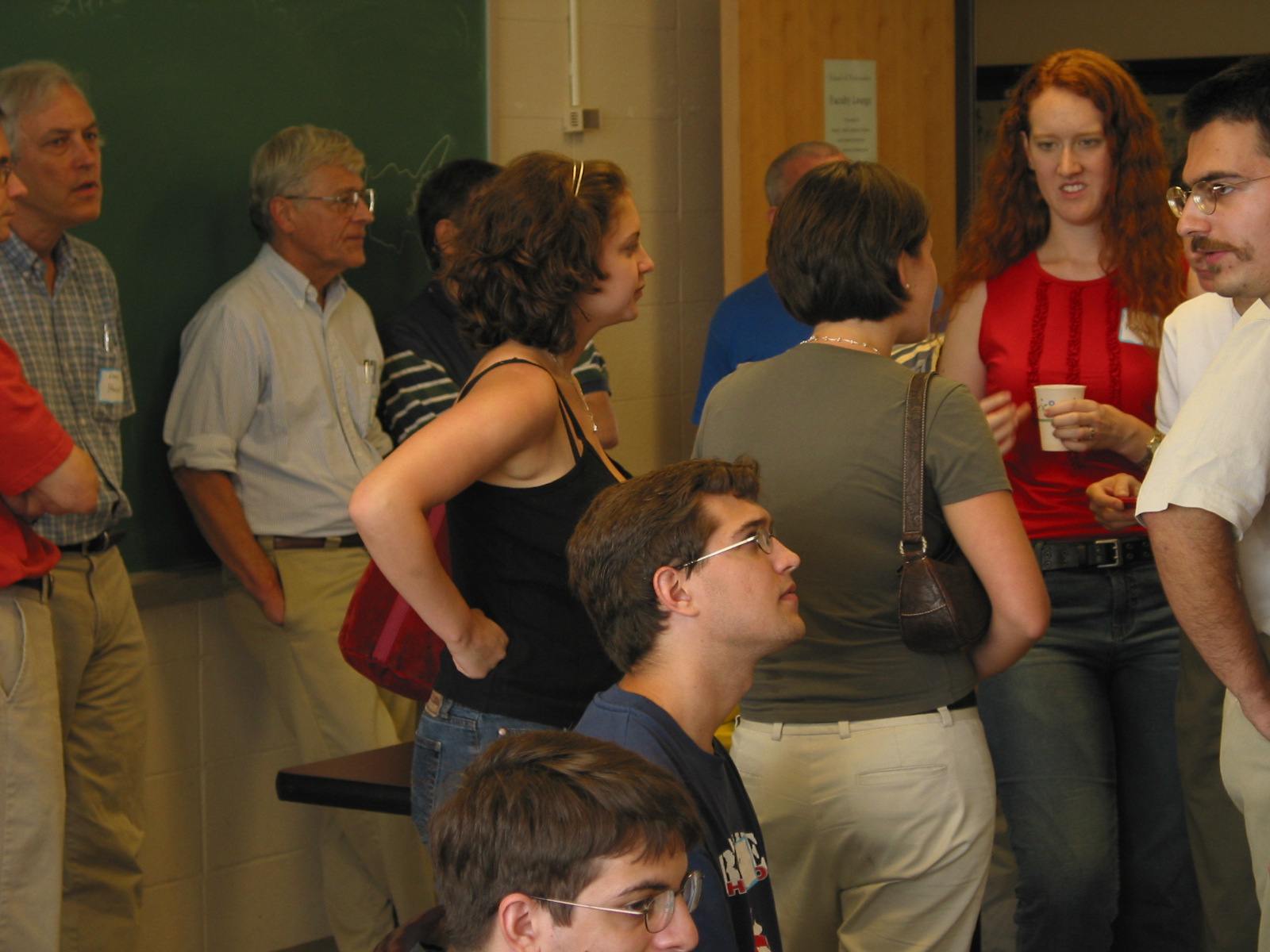 |
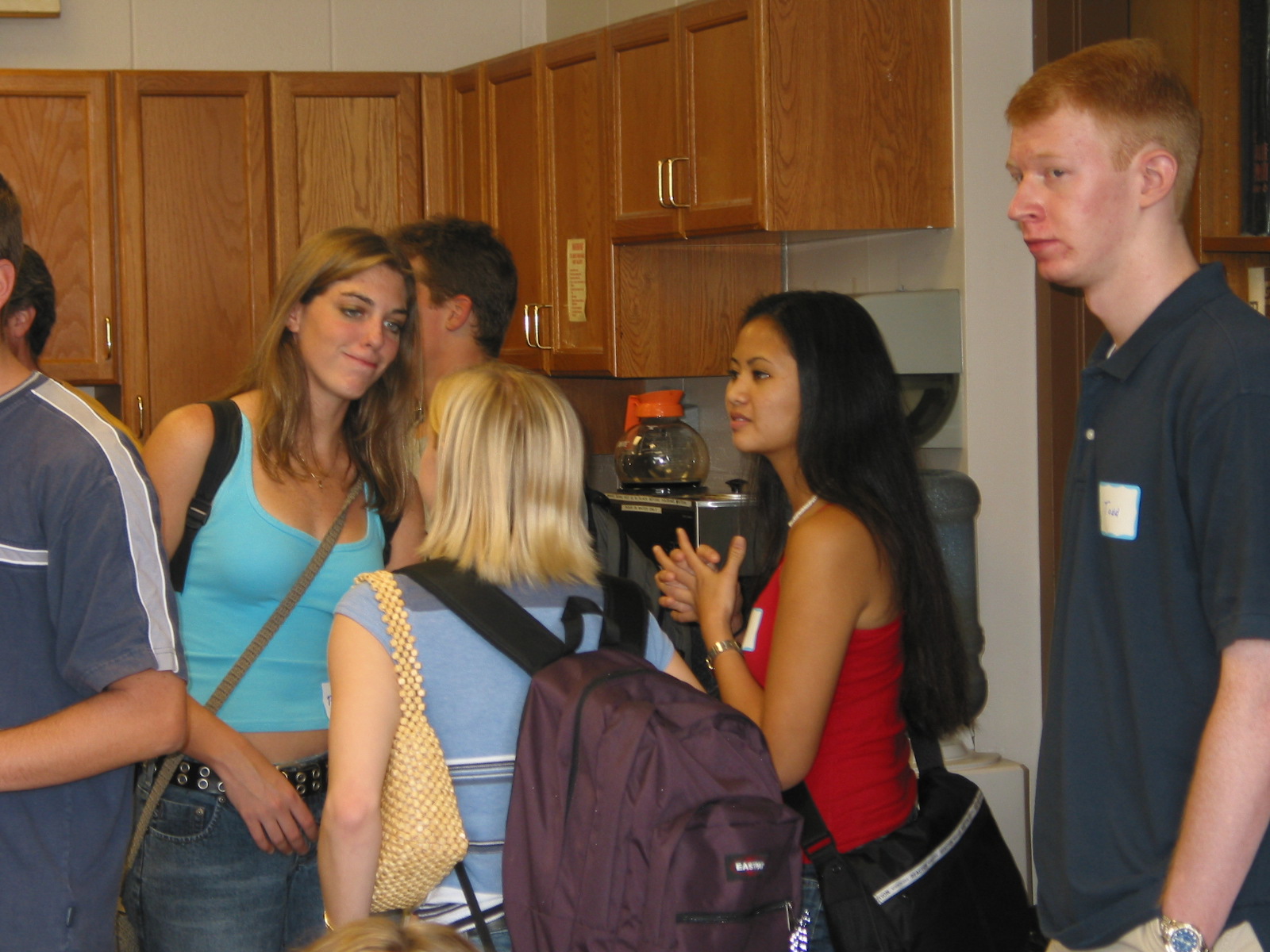 |
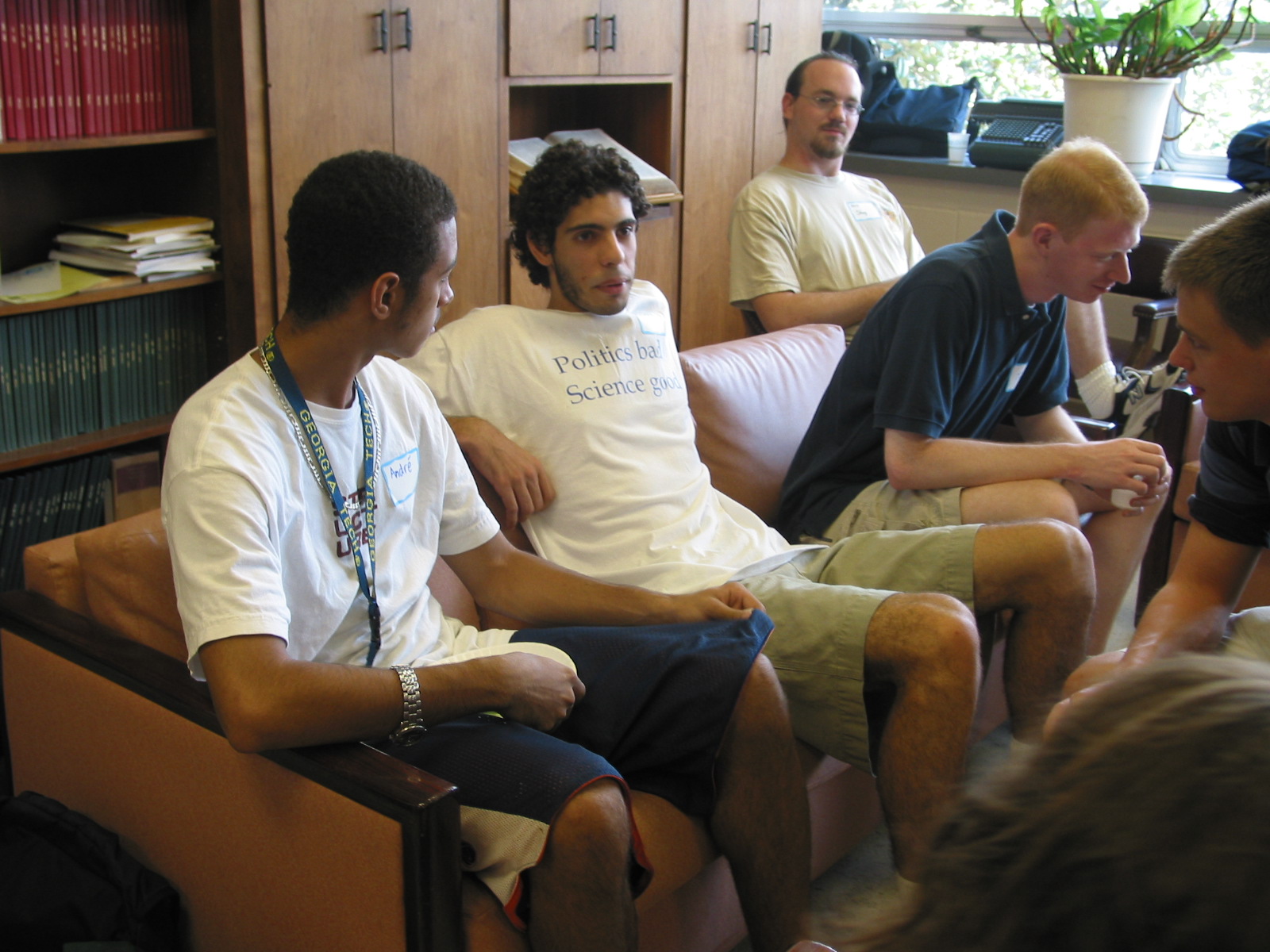
Nick Bronn is Heading to Cambridge
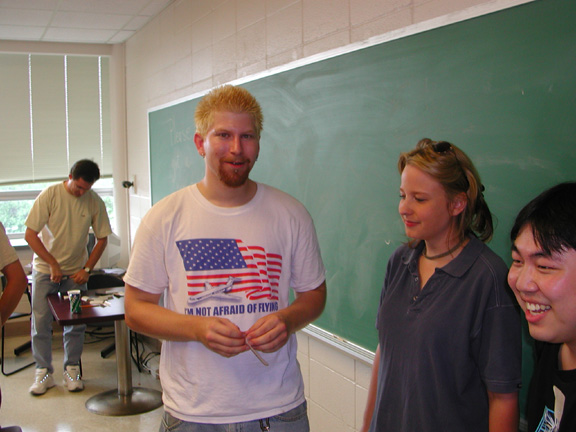 (Aug 2002) Nick Bronn, an Applied
Mathgraduate from August 2001, was back on campus just for a day
recently.He won the Gates Cambridge Fellowship, which he will! use to
study Mathematical Physics at Cambridge University in England. He was
back on campus to seeold friends. One person he wanted to see was
Amanda Gable, who was a bighelp to him in preparing his application for
this prestigious award.
(Aug 2002) Nick Bronn, an Applied
Mathgraduate from August 2001, was back on campus just for a day
recently.He won the Gates Cambridge Fellowship, which he will! use to
study Mathematical Physics at Cambridge University in England. He was
back on campus to seeold friends. One person he wanted to see was
Amanda Gable, who was a bighelp to him in preparing his application for
this prestigious award.
Nick graduated with a BS in Applied Math, one in Physics, anda Masters in Electrical Engineering. For more information about him, see last semester's blog.
Study Abroad? Start Planning Now!
If you participate in any of these programs, Professors Laceyand Steinbart will work with you to count these courses as transfer credit,so that your graduation date will not be postponed. We want you to takeadvantage of these opportunities.
Budapest Hungary has produced a large number of excellent mathematicians, makingthis a program with excellent promise. David Eger has taken part in the semester there, so you have excellent opportunity to learn more about the program.
Moscow has also produced an astonishing number of mathematicians, and before the break up of the Soviet Union, had one of the most accomplished math education programs in the world. A semester in Moscow would add a great deal to your math education. There are Grantsavailablefor this study abroad! Our major Elizabeth Sanders is attending thisprogram for the Fall Semester, and she was awarded one of the fellowships as well.
The deadline for the for Spring Semester in Moscow is Sept. 30, and for the fall semester April 15.
You can travel to Penn State University for an excellent intensive semester in mathematics. The Mass Program offers small classes, lead by world experts in topics like combinatorics and dynamical systems.
Professor Thomas Cont! ributes to Solution of Perfect Graph Conjecture
A Graph is perfect if for each induced subgraph the chromaticnumber of the graph is equal to the size of the largest clique. The chormatic number of a graph is the smallest number of colors needed to assign each vertex of the graph a color, so that no two vertices that are connectedby an edge have the same color.
A clique is the a subset of verticies so that any two verticies are connected by an edge. In graph theory speak, the induced graph iscomplete. In a clique, every vertex must have it's own color, since itis connected to every other vertex in the clique. So the chromatic numberis always as big as the largest clique.
Now, identifying perfect graphs is not easy, as the chromatic number is notoriously difficult to compute. (This common experience is even thebasis of some cryptographic routines.)
The Strong Perfect Graph Conjecture (now Theorem) characterizes prefect graphs in much simplier terms, those of a cycle whose lengthis an odd integer at least 5. A cycle is simply a path that starts andends at the same point without visiting any vertex twice. Such graphs arenot perfect! The chromatic number of a pentagon is three, and the clique! size is 2.
In the other direction, if you take a the complementary graph to one of these cycles, it is also not perfect. The Strong Perfect Graph Theorem says that the graph is perfect if neither it nor it's complement contains an induced subgraph that is a cycle of odd length of at least 5.
Perfect graphs have connections to a wide variety of issues,from coding theory to integer programing. The Strong Perfect Graph Theoremwill likely provide further advances on these subjects.
Professor Thomas is a full professor at Georgia Tech. He teaches courses at the undergraduate and graduate level on combinatorics, and has a very strong record in training both undergraduates and graduates in mathematics.
Primality Testing in Polynomial Time
Algorithms to test primality have great current interest due to the wide spread use of cryptographic routines such as the RSA encryption method. This method is not secure if one can quickl! y factor a large integer. Known methods of factoring and previous methods to test primality havefrequently relied on heuristics arising from the time tested observationthat primes obey certain laws characteristic of random variables. Thusthe algorithms have a non--deterministic running time, and have a smallprobability of not returning an answer.
The current algorithm runs in time given by (log n)^k, wherek<=12. And the authors suggest that k could be as small as 6. It isnot clear that the algorithm provides a factorization, which is after allasking for more information. Current implementations of RSA use integers with log n about 1028. This raised to the 6th power would be about 10^18. This time, while large, is still much smaller than the best factorization algorithms, which run in super polynomial time.
Professor W. T. Trotter is the new Chair of the School of Mathematics
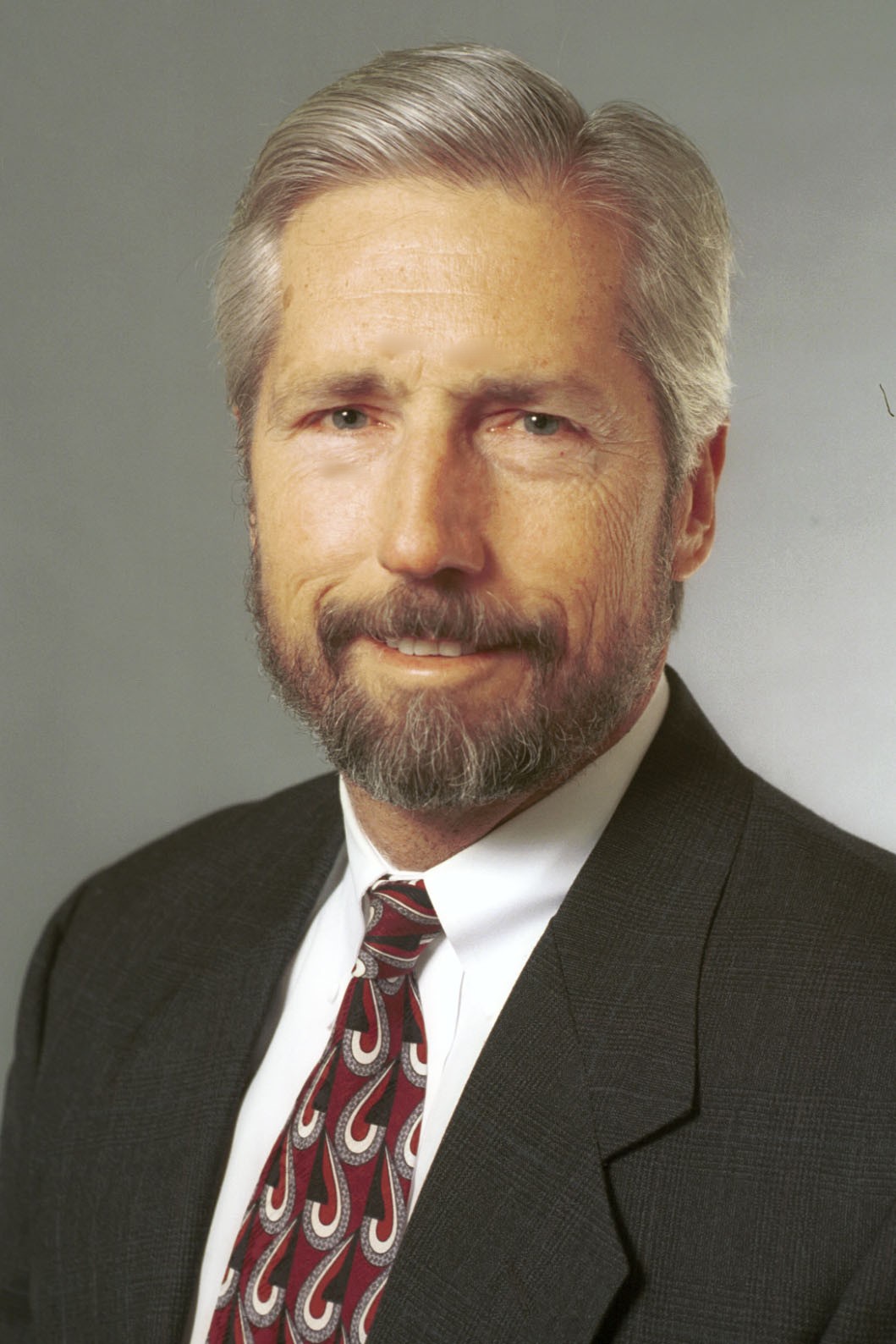 We welcome Professor William T.
Trotteras the new Chair of the School of Mathematics. Professor
Trotter was aVice-Provost and Regent's Professor at Arizona State
University. His firstposition at Arizona was Chair of the Mathematics
Department, and beforethat he was Chair of the Mathematics Department
at the Univeristy of SouthCarolina at Columbia.
We welcome Professor William T.
Trotteras the new Chair of the School of Mathematics. Professor
Trotter was aVice-Provost and Regent's Professor at Arizona State
University. His firstposition at Arizona was Chair of the Mathematics
Department, and beforethat he was Chair of the Mathematics Department
at the Univeristy of SouthCarolina at Columbia.
His research specialization is in Combinatorics, and in particular Partially Ordered Sets. He has descriptions of some of open problems he is interested in on his home web page. One of the reasons that Professor Trotter took the Chairs position was the strong committmen! t the facultyhad to teaching and interacting with the undergraduates at Georgia Tech.H e is eager to meet these undergraduates. It could be that some majorwill be learning more about one of his open problems next summer in theSchool's Research Experience for Undergraduates program.
He takes over the position from the Interim Chair, Professor Richard Duke, who served for four years. During this period, the Schoolcontinued a vigorous hiring campaign. He played a key role in winning theVIGRE/GT grant last year. And secured the funds to form the ACE Lab, the laboratory that combines Algorithms, Computation and Experiments, with some modeling too.
We Welcome 25 Entering Freshmen Math Majors
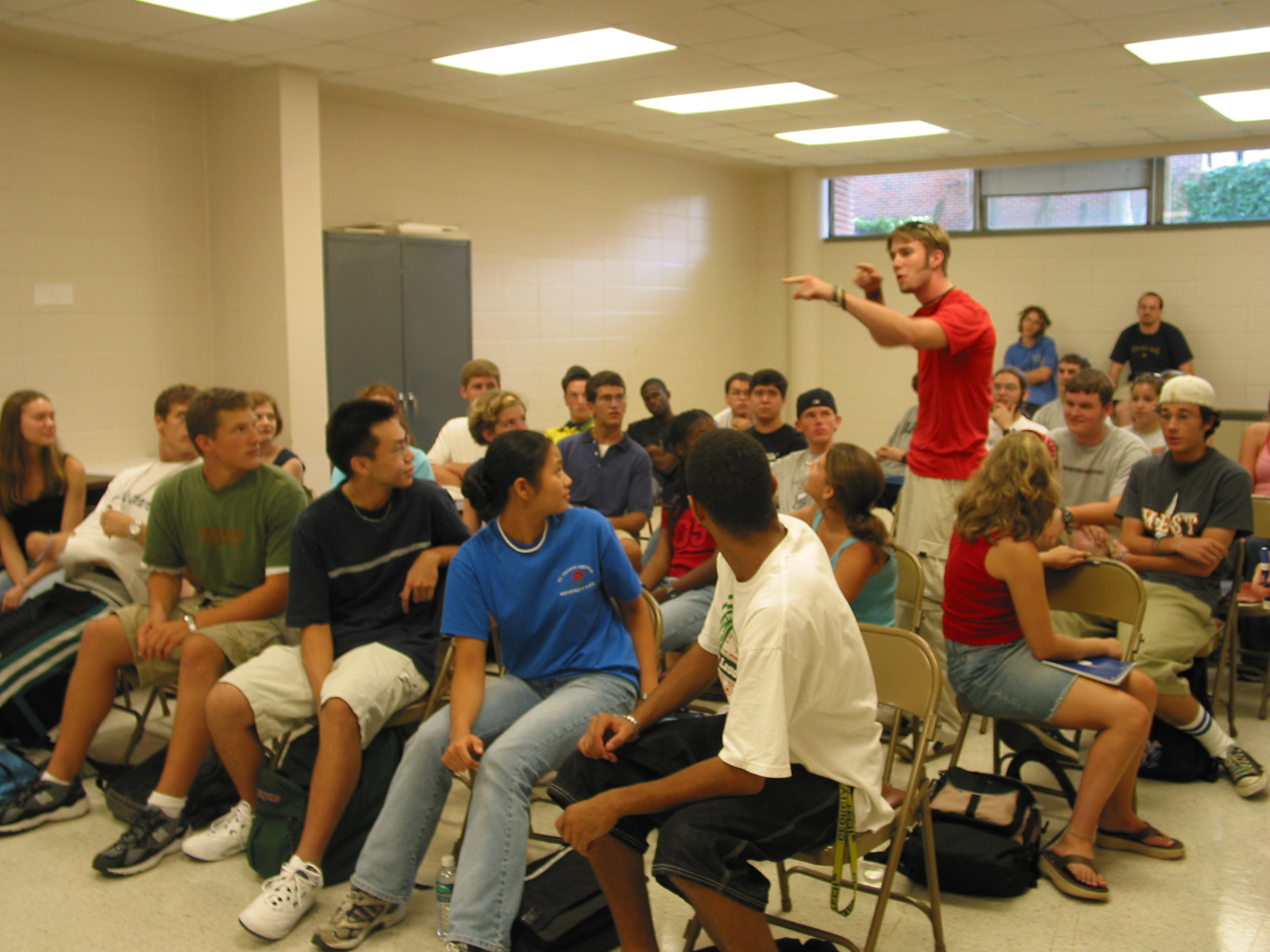 The entering class has 25 entering
freshmanApplied and Discrete Math majors. This i
s twice the entering
freshmenmath majors from last year. Among these students, 12 are
women. These25 students have an average SAT score of 1365, with most
of that from theMath score, of course. Six scored 790 or 800 on the
Math portion on theSAT, and of these, half are women. And there was
only one who scored aperfect 1600 among these 25. You go girl!
The entering class has 25 entering
freshmanApplied and Discrete Math majors. This i
s twice the entering
freshmenmath majors from last year. Among these students, 12 are
women. These25 students have an average SAT score of 1365, with most
of that from theMath score, of course. Six scored 790 or 800 on the
Math portion on theSAT, and of these, half are women. And there was
only one who scored aperfect 1600 among these 25. You go girl!
Most of the freshmen will be at the "Meet the Majors" event on September 3rd. (Details are below.) Come by to introduce yourself to introduce yourself to the newbies, and fill them in on the kool things they can dowhile studying here.
!Besides the Freshman, there are also new Math majors who have switched, or are pursing double majors. We'll try to get them to be at the "Meet the Majors" event as well.
Applying for Grad School Workshop, 11 am, Tuesday Aug 20th, Skiles 255
There are great reasons to attend graduate school, and a wide range options for graduate school. We will go over some of them, supplying some guidelines for helping applicants narrow their search for graduate school. Most of you will not be paying for grad school. There are Teaching Assistants, and Fellowships for graduate school. We will go over some of these possibilities as well. Some fellowship deadlines fall early in the Fall semester, and the applications can take some time to organize. Both I and Amanda Gable can help with that process.
Follow the Grad School links for some information right now.
Meet the Math Majors, Tuesday, September 3, 11-1am, Math Lounge, Second Floor of Skiles
Come by, socialize, and catch up.
National Security Agency REU program, with an October 15 deadline
THE DIRECTOR'S SUMMER PROGRAM
at
THE NATIONAL SECURITY AGENCY
CRYPTOLOGIC MATHEMATICS FOR EXCEPTIONAL UNDERGRADUATE
MATHEMATICIANS
Mrs. Jacqueline A. Holmgren, Program Administrator
math@afterlife.ncsc.mil
***********DEADLINE IS 15 OCTOBER*************
The Director's Summer Program is the National Security Agency's
premier outreach effort to the very best undergraduate mathematics
majors in the country. Each summer we invite 25 exceptional math
students to participate in a 12-week program where they collaborate
with each other and with NSA mathematicians on mission-critical
problems. Admission to the program is highly competitive and is
intended primarily for!
students between their junior and senior
year, but exceptional freshman and sophomores will also be
considered. Graduating seniors will be considered too, but they
must be enrolled in a mathematics graduate program for the fall.
Students will be paid a salary based on experience and yea
r in
school. Minimum requirements are one full year of abstract algebra
and one full year of analysis, or equivalent. Computer background,
especially C or C++, is desirable but not required.
The goals of the Director's Summer Program are to:
* Introduce the future leaders of the U.S. mathematics
community to the Agency's mission and share with them the
excitement of working on mathematics problems of national
importance,
* Provide a deep understanding of the vital role that
mathematics plays in enabling the Agency to tackle a diverse
set of technical challenges,
* Encourage bright undergraduate mathematics majors to continue
their study of mathematics and pursue careers in the
mathematical sciences,
and, of course, to
* Provide solutions to current operational problems.
The students participating in the program work on a broad range of
problems involving applications of Abstract Algebra, Geometry,
Number Theory, Combinatorics, Graph Theory, Probability, Statistics,
and Analysis. For the first two weeks of the summer, lectures on
modern cryptologic mathematics are given. After the lectures, the
students are presented with about ten current problems and choose
one or two as the focus for their research. All research is
documented in a series of papers written by the students near the
end of the summer.
Throughout the summer, students develop mathematical theory, apply
what they learn to obtain real-time solutions, and experience the
excitement of success built on hard work and innovation. Most!
students find the work at NSA very exciting and challenging and many
decide to return for another summer. State of the art computing
resources are available to all students. For the most part
programming is done in C in a UNIX environment. Computational
algebra packages including MATHEMATICA,
MATLAB, MAGMA, MAPLE are
available in addition to a variety of statistics packages.
Because of the lengthy security processing required, the deadline
for applications is 15 October each year for the following summer.
To apply, students simply send a resume, at least two letters of
recommendation from faculty members familiar with their work, and a
copy of transcripts through the current academic year. **Students
must be U.S. citizens. The Director's Summer Program is an
extremely rewarding summer experience! All information should be
sent to: Department of Defense, National Security Agency, 9800
Savage Road, Fort George G. Meade, MD 20755-6515, Attn: R1 (DSP),
Suite 6515.
For additional information about the Director's Summer Program, call
Mrs. Jacquie Holmgren, Program Administrator at (301) 688-0983 or
send e-mail to math@afterlife.ncsc.mil.
Jacquie Holmgren
DSP/GMP Program Administrator
(301) 688-0983 work
(301) 688-0689 fax